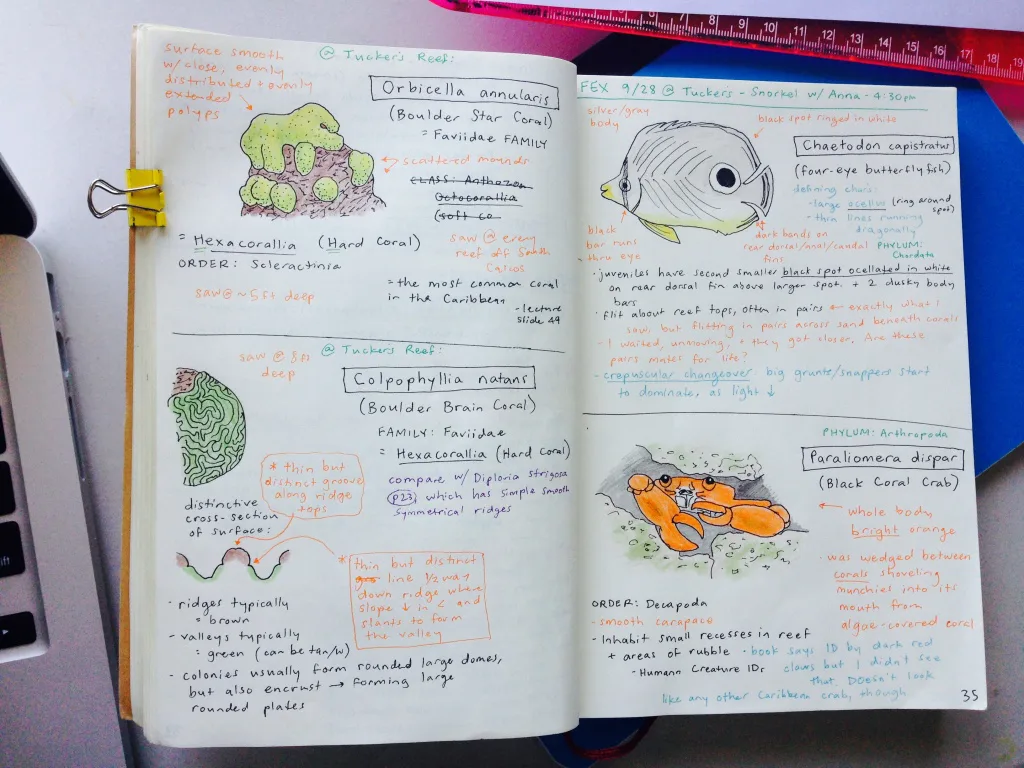The Field Journal
It has been over a month now since I arrived at the “School for Fields,” as the people of South Caicos call our campus, but it feels like only yesterday that my daughter and I stepped off the InterCaribbean flight and were welcomed by Heidi Hertler, Center Director, at the airport. Within days, I leapt head first into teaching the Tropical Marine Ecology course. Although I have taught numerous marine subjects in both brick and mortar classrooms and at sea over the years, this is my first opportunity to do an entire semester-long ecology course at a field station. Not only were the students excited, but so was I. What work would we be able to do together? How could I maximize our immediate access to the water, weather, reefs and infinite new critters, while teaching taxonomy and research methods, and keep their sense of wonder alive and vibrant? I decided to fall back on my favorite teaching tool – the field journal – after all, how better to capture the heart and soul of the field station experience?

Stephanie Bellinghausen
The SFS Center for Marine Resource Studies is incredibly fortunate to have the ocean literally rolling up to our doorstep, and a fantastic waterfront team that supports all daily field exercises. A field journal, I hoped, would allow the students not only to do their scientific work, but also to capture their ideas, their experiences, and that wonder that all of us who love the ocean are endlessly driven by. And perhaps, I thought, maybe there are some talented artists in the group.

Zoe McWatters
We began the semester with the usual introductory topics, ocean environments and primary production, but quickly moved onto topics of more immediate relevance: the biology and ecology of mangroves, seagrasses, fish and corals. I gave the students a big challenge: document 20 species from each of the three key environments we visit here to start your journal. At first, many students found the journals most helpful in simply focusing on one or two species, until they could tell one fish from another, or a seagrass from an algae, or corals from sponges. For some, this was old hat as they had seen and ID’d many fish before, but for others every fish on the reef was new, let alone corals. I encourage collaboration, and every free moment the students had, they gathered together hovering over Paul Humann and Ned DeLoach’s books, helping each other ID their new fish or sponge and discovering special things about them.
One thing we ask of the students is that they become conversant in the scientific names of the species we study and interact with. So what better way to build their basic taxonomy and nomenclature one species ID at a time from the field? In addition, I encourage the students to capture any observations and questions they might have about the species they are documenting in their journals. The work they have done is amazing!

Zoe McWatters

Becky Shelton
For years I have been using scientific journals in my teaching as the basis for helping students become independent thinkers, constructing scientific knowledge through their first hand experiences of natural phenomena. Soon the students were looking into more intriguing and nuanced elements of the systems we study: fish behaviors such as schooling or being solitary, seeking refuge in shadows or being brightly colored, community membership in each ecosystem and what species are in all three habitats, diurnal and nocturnal shifts, etc… The observations and questions are not necessarily new or ground breaking, and many can be answered by a Google search, but that is not the point. The point is to hone their eyes, to develop an observational lens that is theirs and theirs alone.
“Sixty species?” the class asked in a collective panic. “Yep,” I said. Not only did they do the work of recording, researching, observing, and thinking about the 60 species they recorded, many of them went far beyond my initial expectations. Far more importantly, though, the students began to ask fabulous questions, pose potential experiments or commit themselves to going back and observing the species that had grabbed their attention again and again.
The next phase in our work together will be to develop our whole ecosystem thinking and the students will learn the scientific methods used to answer their questions: fish surveys, belt transects, rugosity measurements, etc. In their journals, each student will document the methods they are learning, the kinds of questions these methods can answer, and they will get their first chance to work with original field data that they have collected. Given the wonderful work I have seen so far, I expect that these students will do a fantastic job. The goal of course, is for them to come away from the “School for Fields” with a journal that they will each treasure; a journal that documents their journey from the classroom to living and breathing the marine environment; and a place where they can return to in the future, and see themselves emerging as a true field scientist.
Related Posts


Alumni Reflections: Stories of the Return to Kenya
